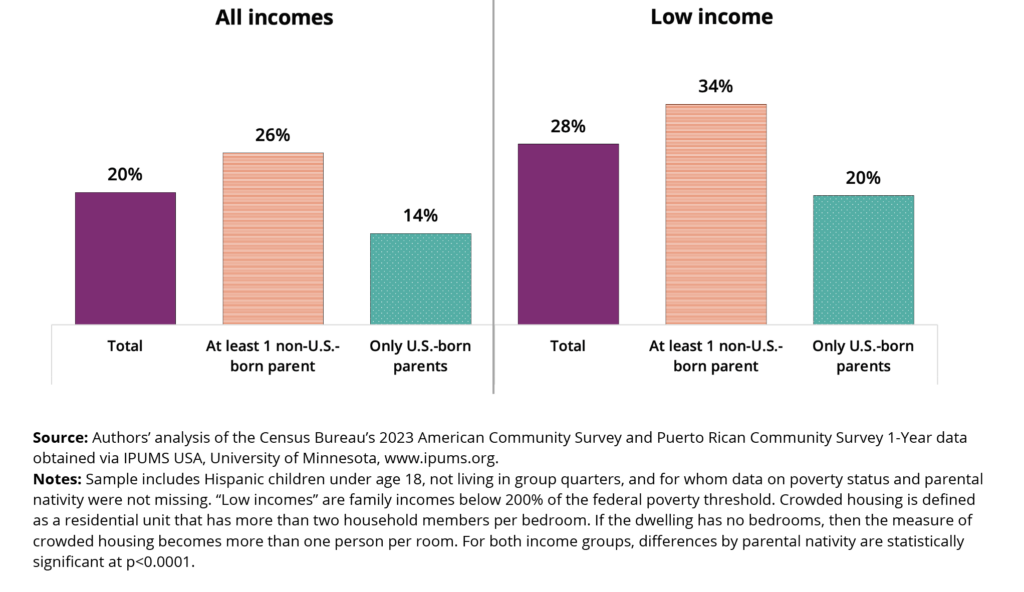Jul 15, 2025
Data Point
More Than One in Four Hispanic Children in Families With Low Incomes Live in Crowded Housing
Authors:
Among Hispanic families with low incomes (families whose incomes fall below 200% of the federal poverty threshold), more than one in four children are living in crowded housing—commonly defined as a household with more than two members per bedroom1—according to our new analysis of the 2023 American Community Survey. Among all Hispanic families, irrespective of their family incomes, one in five children live in crowded housing.
Figure 1. Crowded housing is the reality for more than one in four Hispanic children in families with low incomes.
The percentage of Hispanic children in families living in crowded housing, by family and whether their parents were born in the United States, 2023
 The experience of crowded housing also varies by whether parents were born in the United States. Just over one third (34%) of Hispanic children in immigrant families (children with at least one parent in the household who was born outside the United States) with low incomes live in crowded housing, compared to one fifth (20%) of those who live with only U.S.-born parents.
The experience of crowded housing also varies by whether parents were born in the United States. Just over one third (34%) of Hispanic children in immigrant families (children with at least one parent in the household who was born outside the United States) with low incomes live in crowded housing, compared to one fifth (20%) of those who live with only U.S.-born parents.
Although crowded living conditions are not always harmful, children who live in crowded housing tend to fare worse than other children, on average, across a range of outcomes, including math and reading achievement, behavioral outcomes, physical health, and—persisting into early adulthood—educational attainment. Crowded housing conditions can impact children’s health and well-being directly via, for example, a lack of privacy or personal space to sleep or do schoolwork and an increased risk of exposure to communicable diseases. Crowded housing can also indirectly impact children’s well-being via factors such as increased stress that can negatively impact the quality of the household’s family dynamics, including around parenting.
Crowded housing is a key dimension of a family’s housing conditions that policymakers monitor. Other dimensions include housing quality, stability, ownership, and affordability, as well as families’ access to subsidized housing. A range of federal programs support families’ housing needs, including housing vouchers, publicly subsidized housing, and rental assistance. While few programs directly target crowded housing, making housing more affordable can help with crowding. For example, recent research shows that crowded housing conditions were reduced in families who received rental assistance. Unfortunately, the demand for rental assistance outpaces supply, and only one in four families who are likely eligible for this assistance receive it.
To help fill this gap, some states have leveraged the flexibility of the Temporary Assistance for Needy Families (TANF) program to help families with children pay for their rent, utilities, and other housing-related necessities. To maximize TANF benefits for Hispanic families, states should ensure that their policies and administrative practices for determining eligibility and applying for assistance don’t create barriers to accessing the program. Additionally, other programs that serve a large number of Hispanic families—such as Head Start—can also help identify families in need of housing assistance and connect them to valuable federal, state, and local resources. For families with low incomes living in crowded housing, these supports may reduce other day-to-day housing and economic stressors that may make crowded conditions more stressful.
Method
For this analysis, we used data from the U.S. Census Bureau’s 2023 nationally representative American Community Survey (ACS) and Puerto Rican Community Survey (PRCS) 1-year samples, obtained from IPUMS USA. We define Hispanic children as children under age 18 for whom a Latino, Hispanic, or Spanish origin was reported, regardless of race. There are 136,816 Hispanic children in the unweighted sample, including 59,873 Hispanic children in families with low incomes. Our analyses excluded Hispanic children living in group quarters, those with missing poverty data, and those without parental nativity data.
Our measure of crowded housing uses the data on each household’s number of rooms, number of bedrooms, and number of household members to identify households with more than two members per bedroom; or more than one person per room for dwellings with no bedrooms (such as studios or efficiency apartments). We created the category of families with low incomes, defined as family incomes below 200 percent of the federal poverty threshold, using the IPUMS-constructed poverty variable, which calculates each person’s family income as a percentage of their family’s poverty threshold (see this summary of the ACS poverty measure in IPUMS). We also show estimates according to whether children’s coresidential parents were born in the United States (i.e., their nativity) using two categories: 1) at least one parent in the household was born in another country or 2) all parents in the household are U.S.-born. For children with only one parent in the household, parental nativity was assigned based on the nativity of that parent alone.
Suggested Citation
Wildsmith, E., & Alvira-Hammond, M. (2025). More than one in four Hispanic children in families with low incomes live in crowded housing. National Research Center on Hispanic Children & Families. DOI: 10.59377/501r7567i
1 Another commonly used definition is more than one person per room living in the household.




